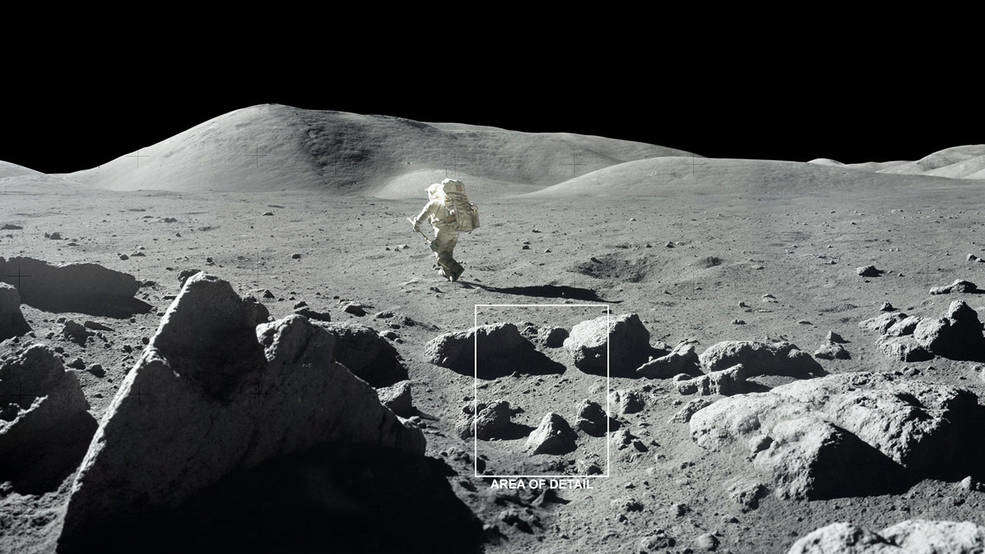Create a free profile to get unlimited access to exclusive videos, sweepstakes, and more!
Could shadows on the Moon tell us where to find hidden water?

Craters might be the obvious places to look for water on the Moon, but there are unexpected places that have been hiding in plain sight.
The Man in the Moon became a thing, immortalized by Georges Méliès in his 1902 film A Trip to the Moon, because the lunar surface is anything but flat. Sure, it is pockmarked with craters that never see the light of the Sun, but the Moon also has many other irregularities that cast shadows which keep it freezing enough for it to form. So how is that possible when so many observations have shown the surface to be flat?
As a team of NASA JPL scientists led by Björn Davidsson and Sona Hosseini recently found out, those computer models hadn’t considered the surface features that showed up in Apollo mission photos. Factoring them into the model showed a surface with irregularities everywhere. That ended up demystifying something else having to do with why water distribution on the Moon keeps changing from day to night.
“Shadows can be created by any geological surface features such as rocks, hills, surface texture, and even lunar craters,” Hosseini, who co-authored a study recently published in Monthly Notices of the Royal Astronomical Society, told SYFY WIRE. "For the largest deposit of water, our best bet would be to look into the permanently showed regions (also called as PSR) since water and other volatiles had lots of time (millions of years) to accumulate and gather in them
There is next to no lunar atmosphere. Here on Earth, there is a transfer of energy between the atmosphere and the surface, and some of that turns into heat energy that warms the surface, allowing myriad life-forms to thrive. The Sun will radiate heat that hits the ground. That heat will eventually rise up from the ground and through the air. Lack of an atmosphere means that this is not possible on the Moon—meaning areas where temperatures can plummet to -350 degrees Fahrenheit can coexist with ultra hot regions and experience no transfer.
Looking at the updated computer model and knowing the impossibility of certain phenomena that can only happen with an atmosphere, Hosseini and her team realized that there is a distribution of water going on. Frost forms in shaded areas after dark. During the daytime, when the lunar surface is exposed to brutal radiation, water molecules travel to the upper part of (whatever can pass for) the Moon’s atmosphere, the exosphere. They drift back down and accumulate in different shaded areas as sunlight fades, turning to frost as temperatures drop.
This is why Hosseini, a research and instrument scientist, is trying to develop tiny, hypersensitive sensors that will be able to pick up on signals from lunar water ice, which are extremely faint. These will be part of the Heterodyne OH Lunar Miniaturized Spectrometer (HOLMS) that can be used on an autonomous lander or rover like the Autonomous Pop-Up Flat Folding Explorer Robot (A-PUFFER) also created at JPL. HOLMS sensors will find and measure hydroxyl molecules, each of which is made of one hydrogen and one oxygen atom. Sending out several HOLMS to different regions of the Moon would be able to make sense of how shadows affect other volatiles besides water, including sodium and potassium.
"HOLMS is in the development phase, and we are working hard to be selected for future missions so we can make these measurements," she said. "Once sent to the Moon, HOLMS would make measurements from different angles from the exosphere from different directions. With the new findings, we will be able to estimate how many water signals we can expect from each direction after sunrise and throughout the day."
Hydroxyl can indicate how much water may be floating around in the exosphere because it is related to water, which has one more hydrogen atom. The shift in water distribution isn’t just the result of water being transported from place to place on the Moon’s surface. Anything containing water ice that crashes into the Moon, such as meteorites, can create water. So can solar wind particles that bombard lunar regolith.
"The amount of water we’re talking about is super tiny, but considering the transfer cost to space, any amount of in situ resources is a huge deal," Hosseini said. "Now that we established shadows and temperatures play a crucial role, I’d say we need to have a better understanding of regolith properties."
While future crewed Artemis missions will probably land near craters guaranteed to have more than enough water ice for drinking, fuel and breathable oxygen, finding ice all over the Moon could mean a new outlook on how both machines and astronauts refuel.


























